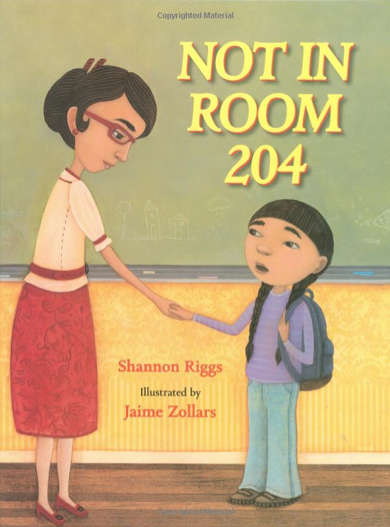 My sexual abuse prevention unit for fourth grade consists of two lessons that focus on how to recognize and report about grooming and sexual abuse. Each lesson begins with a read-aloud story in which a child grapples with complex uncomfortable feelings and how to tell about what has happened. Follow up activities help students think about why it might be hard to tell; understand how telling can change how a kid is feeling; figure out ways to tell, even when you’re feeling very uncomfortable; and practice telling about unsafe or uncomfortable situations.
My sexual abuse prevention unit for fourth grade consists of two lessons that focus on how to recognize and report about grooming and sexual abuse. Each lesson begins with a read-aloud story in which a child grapples with complex uncomfortable feelings and how to tell about what has happened. Follow up activities help students think about why it might be hard to tell; understand how telling can change how a kid is feeling; figure out ways to tell, even when you’re feeling very uncomfortable; and practice telling about unsafe or uncomfortable situations.
These lessons revisit and build upon skills and concepts that I cover in previous grades, but prior knowledge is not necessary, so you can use them as a starting place even if your students haven’t already had lessons about safe touch.
For these lessons you will need the books Not in Room 204: Breaking the Silence of Abuse by Shannon Riggs and No More Secrets for Me by Oralee Wachter. You will also need some activity pages that you will find linked below. The lessons as written take 45 minutes. It will be helpful for you to familiarize yourself with the foundational information about how to teach sexual abuse prevention by reading the posts Teaching Kids How to Tell About Sexual Abuse, Teaching Kids to Recognize Grooming, and Preparing Students (and Yourself) for Sexual Abuse Prevention Lessons before you teach the lessons. You can link to all my posts about sexual abuse prevention lessons and resources by visiting A Collection of Sexual Abuse Prevention Resources. The objectives and ASCA National Standards addressed in this unit are listed at the end of the post.
Lessons and Materials
Lesson 1 begins with reading Not in Room 204, a story about Regina Lillian Hadwig, a sad, quiet girl in Mrs. Salvador’s class, Room 204. You are going to love Mrs. Salvador! She is pretty much a school counselor disguised as a classroom teacher! Mrs. Salvador consistently provides safety in her classroom, where students keep their desks neat, work hard, respect others, speak kindly, and keep their bodies to themselves. When her expectations are not met, she gives gentle but firm consequences and reminders that, unsafe things may happen elsewhere, but “not in Room 204.” Regina is very quiet, but she watches and listens to Mrs. Salvador very carefully. Something unspecified, but upsetting, has been happening to Regina: “There were things her father did that Regina Lillian Hadwig kept so quiet about, not even her mother knew.”
When Mrs. Salvador reads a book about Stranger Danger to the class, she tells them “It’s not always strangers who touch children in ways they shouldn’t be touched. Usually it’s someone the child knows.” She goes on: “If someone told me this happened I know exactly what to do.” The next morning Regina arrives at school early and tells Mrs. Salvador what has been happening. Mrs. Salvador knows exactly what to do. On the very last page, for the first time, Regina smiles.
The story and illustrations in Not in Room 204 offer a lot of information and many great discussion starters:
- What did Regina do to help herself be safe?
- How can you tell that Mrs. Salvador is an adult who can be trusted to help kids if they’re not safe?
- Why do you think Regina is so sad and quiet?
- Why do you think Regina didn’t tell right away?
- How did Regina’s feelings change after she told?
- Who is someone like Mrs. Salvador that you know? Is that a person you could trust to tell if something was making you feel uncomfortable, yucky, or scared?
Although what has happened to Regina remains unspecified, there is a picture of her at bedtime, with a shadowed man outside her door. When someone inevitably asks what actually happened to Regina, I tell them that we can’t be sure, but that it seems like it was sexual abuse. I re-read the quote “There were things her father did that Regina Lillian Hadwig kept so quiet about, not even her mother knew,” and point out that that shows that there is an uncomfortable secret. The bedtime pictures, Regina’s deep sadness, and her conflicting desire to tell and feelings of fear are other clues that the situation is probably sexual abuse.
 After the discussion we do a group activity in which kids take turns reading statements about how kids feel after telling about abuse. You can read more about this at “I Got Safe So Quickly!”: How Kids Feel After Telling About Sexual Abuse. The statements are on small pieces of paper, folded into quarters. You can download a copy of these statements here.
After the discussion we do a group activity in which kids take turns reading statements about how kids feel after telling about abuse. You can read more about this at “I Got Safe So Quickly!”: How Kids Feel After Telling About Sexual Abuse. The statements are on small pieces of paper, folded into quarters. You can download a copy of these statements here.
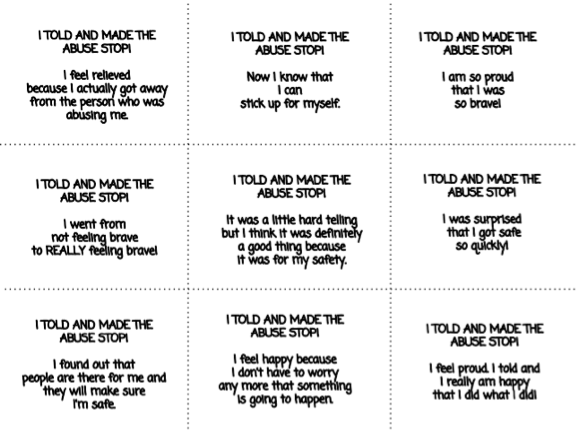 I explain to students that the notes contain the words of real (but unidentified) kids who made the abuse stop by telling an adult who they trusted about it. I distribute one note to each student, then have them unfold and read their notes, one by one, without commenting in between. I ask them to read the heading first and then the statement, so the message “I told and made the abuse stop” gets repeated as many times as there are kids. Depending on the number of kids in the class, some of the notes are duplicates, but the repetition doesn’t hurt. (I let the kids know this in advance so that it doesn’t distract them while they’re sharing them.) After all the notes have been read I ask the kids what they noticed. They generally are quite struck by the positive thoughts and feelings that result from telling. I ask them what they think Regina would have written in a similar note. To wrap up the lesson I tell them that next time we will continue to talk about ways to tell if something uncomfortable or unsafe has happened.
I explain to students that the notes contain the words of real (but unidentified) kids who made the abuse stop by telling an adult who they trusted about it. I distribute one note to each student, then have them unfold and read their notes, one by one, without commenting in between. I ask them to read the heading first and then the statement, so the message “I told and made the abuse stop” gets repeated as many times as there are kids. Depending on the number of kids in the class, some of the notes are duplicates, but the repetition doesn’t hurt. (I let the kids know this in advance so that it doesn’t distract them while they’re sharing them.) After all the notes have been read I ask the kids what they noticed. They generally are quite struck by the positive thoughts and feelings that result from telling. I ask them what they think Regina would have written in a similar note. To wrap up the lesson I tell them that next time we will continue to talk about ways to tell if something uncomfortable or unsafe has happened.
Lesson 2 begins with reading the story “What If” from No More Secrets for Me. (Sadly, this book is out of print, but it is still available from third party sellers on Amazon. Get a copy! This and the other stories in it are really helpful!) Before we read it, I review the definition of “grooming” and I remind them about a third grade lesson about grooming using the book Mia’s Secret, in which Mia was groomed by her mom’s friend, who later abused her.
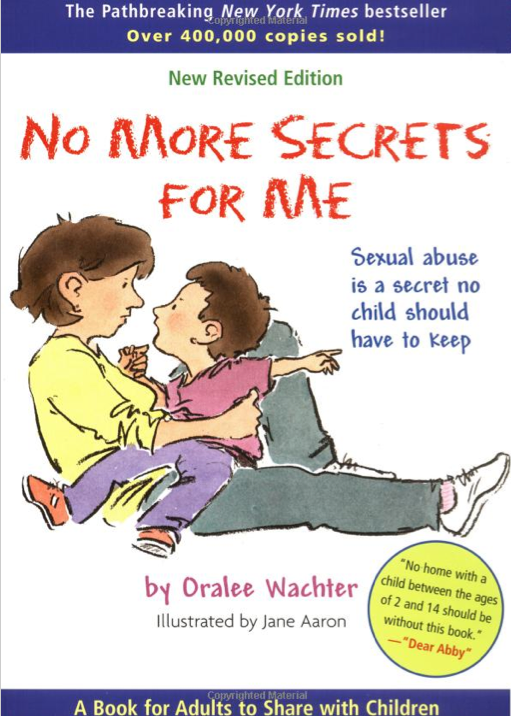 Here is how I explain grooming:
Here is how I explain grooming:
“ Grooming means ‘getting something ready.’ Usually people use the word ‘grooming’ when they are talking about making themselves look clean and neat. On school picture day, you groom yourself by fixing your hair and straightening your clothes so that you are ready to have your picture taken. The word ‘grooming’ is also used to describe what a person who wants to sexually abuse a kid does to trick the kid, or get him/her ready to abuse. Usually a sexual abuser doesn’t abuse a kid right when they first meet. They pretend to be nicer than they are, they trick the kid – and sometimes the kids’ parents – into trusting them and thinking that they are friends.This book is about a boy named Greg, who gets groomed by a camp counselor named Marty. It’s not too scary, because Greg figures out what to do to avoid being abused. While I’m reading I want you to notice what kinds of grooming or tricks Marty tries, and also the things that Greg does to help keep himself and other kids safe. ”
In “What If,” Greg has to figure out what to do when Marty, a camp counselor who he really likes, tries to get him to take off his clothes to play a game. Greg’s situation is confusing – by staying in his tent instead of going to swimming lessons, he has broken camp rules, but Marty is understanding, and says he won’t report him. Marty uses lots of tricks, one after another to try to gain Greg’s trust and compliance – befriending, pointing out their similar feelings of homesickness, teasing (“What are you afraid of?”), cajoling, and threatening. Greg refuses to do what Marty wants, gets away, and tells another camp counselor what happened.
“What If” provides clear examples of the strategies (“tricks”) that perpetrators use to get kids to comply with and keep silent about sexual abuse. It shows how even a previously well-liked person who, based on their role, should be trustworthy, could also be an abuser. It accurately portrays the confusion and conflicting feelings of a targeted child. And it deftly illustrates how kids have the ability to persevere and navigate in the face of a confusing and scary situation to avoid or stop abuse.
Here are some discussion questions that I use after reading the story:
- What did Greg do to help himself be safe?
- Did Greg telling help other kids stay safe? How?
- What are some ways that Marty tried to groom Greg?
- What was Marty trying to get Greg to think and feel with each of his grooming tricks?
- How are grooming and sexual abuse related to bullying?
- What helped Greg stay safe throughout the time he was in the tent with Marty?
- What should Greg have done if the counselor he told about Marty didn’t believe him or didn’t do anything about the situation?
- What advice would you give to a kid in a similar situation?
Following our discussion we do a group brainstorming activity. I ask students to imagine that a kid is experiencing (or has experienced) an unsafe or uncomfortable situation. The kid knows that s/he needs to tell, but isn’t sure how to start telling. I let the kids know that it is my job to help them talk about hard things, and I know how to do that, but they just need to know how to start telling. I tell them that other trusted adults might know how to help them talk too, but if they don’t, kids can always tell me or any other counselor they have, because we are trained to know how to listen and help kids talk.
Here are some ideas that one of my fourth grade classes came up with:
- Say “I feel uncomfortable being around this person.”
- Use a stuffed animal to talk for you.
- Write it down and give it to someone to read.
- Just tell.
- Make a scene so someone knows something is wrong.
- Say “Something is happening.”
- Write it while you’re sitting with a safe adult.
- Say “I’m having trouble saying this.”
- Say “Help me. Something happened to me but I can’t say it.”
- Act it out with dolls from the dollhouse.
- Ask to read books about safety with the school counselor.
- Draw a picture.
- Use colors to show how you feel.
- Use a rubber band to show how stressed you feel.
- Rip or crumple up paper to show how you feel.
- Ask “Do you know what to do if a kid is getting touched inappropriately?”
- Whisper it.
- Ask “Can I have a time to see you?”
- Say “I have something important to tell you.”
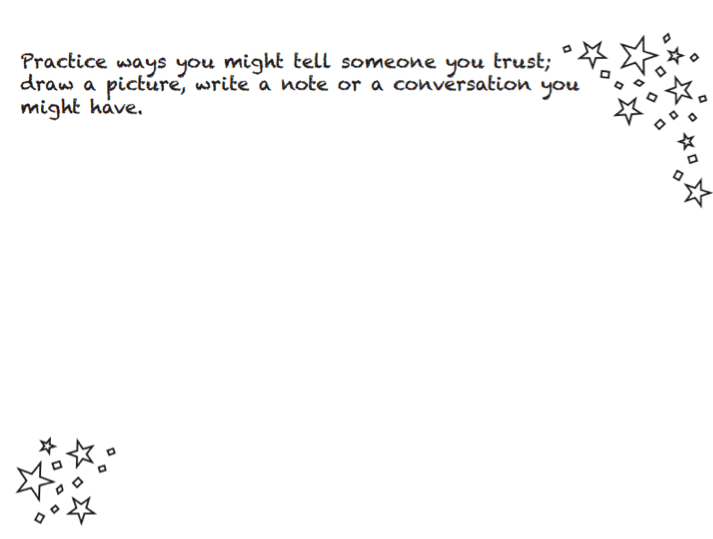 After we finish brainstorming, the kids complete the above “Practice” page from the VIP Coloring Book to show a way that a kid could start telling about an uncomfortable/unsafe situation. The directions on the page say “Practice ways you might tell a person you trust; draw a picture or a note or a conversation you might have.” I tell them that they do not have to share any private information, or anything that really happened, but just need to show or tell at least one way that a kid could start telling about an uncomfortable/unsafe situation such as abuse or bullying. They can choose to write or draw, whichever they prefer, and can refer to the brainstormed list if they need ideas.
After we finish brainstorming, the kids complete the above “Practice” page from the VIP Coloring Book to show a way that a kid could start telling about an uncomfortable/unsafe situation. The directions on the page say “Practice ways you might tell a person you trust; draw a picture or a note or a conversation you might have.” I tell them that they do not have to share any private information, or anything that really happened, but just need to show or tell at least one way that a kid could start telling about an uncomfortable/unsafe situation such as abuse or bullying. They can choose to write or draw, whichever they prefer, and can refer to the brainstormed list if they need ideas.
At the end of the activity I give kids the opportunity to share, if they wish, which strategy they chose. I collect the papers so that I can assess their learning and check to make sure if anyone has shared any private information.
To finish the lesson we talk about which trusted adults kids could tell, and have the class share some ideas. I remind them that different kids will have different feelings about which adults they trust, and that’s okay. I let them know that sometimes kids feel more comfortable telling someone outside of school, like a parent, other relative, or family friend and sometimes they feel more comfortable telling someone at school. I also let them know that sometimes people outside of school don’t know what to do to help a kid feel safe, but a counselor, teacher, nurse, principal, or anyone else at any school will always know what to do to get help.
Objectives and ASCA Standards
Objectives: Students will be able to:
- understand that “yucky” or uncomfortable feelings are an indication that a situation is potentially unsafe, that they should leave if possible, and tell a trusted adult about it.
- tell a trusted adult about any uncomfortable, confusing, scary, manipulative, or dangerous situations they have experienced.
- recognize that their body belongs to them and they have the right to say when and how someone else can touch it.
- identify that secrets and/or threats about touching should be told to a trusted adult.
- recognize that it is not a child’s fault if someone touches them inappropriately.
- understand that sexual abusers may use tricks, bribes, or threats to gain and maintain trust and secrecy.
ASCA National Standards
PS:A1.7 recognize personal boundaries, rights, and privacy needs
PS:A2.6 use effective communications skills
PS:B1.4 develop effective coping skills for dealing with problems
PS:B1.5 demonstrate when, where and how to seek help for solving problems and making decisions
PS:C1.3 learn about the differences between appropriate and inappropriate physical contact
PS:C1.4 demonstrate the ability to set boundaries, rights and personal privacy
PS:C1.6 identify resource people in the school and community, and know how to seek their help
You might also be interested in:
Second Grade Lessons for Sexual Abuse Prevention
You Brought WHAT To School???!!!

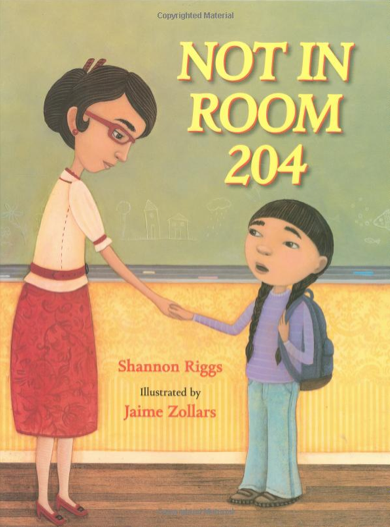

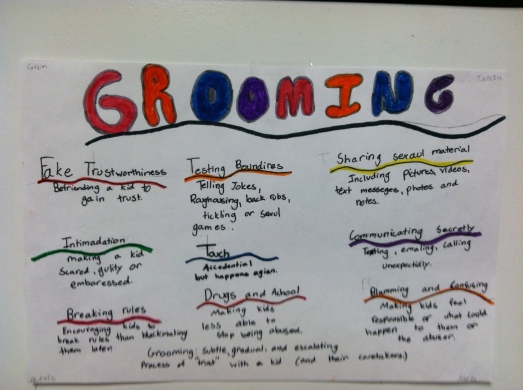
Trackbacks/Pingbacks